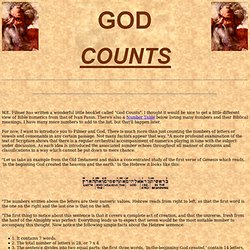Ivan Panin Bible Numerics
Ivan Panin dedicated many years of his life to the study of numeric patterns in the Bible. Here are some of his findings. More evidence of God's supernatural hand of design in the original.

Jack Robinson is a lecturer in statistics at the University of Waterloo in Ontario, Canada. This month’s comments are prompted by the occasional Christadelphian use of the work of Ivan Panin to prove the inspiration of scripture. Jack points out, we should not use Panin’s work to this end. – Editor Almost two years ago, Michael Drosnin’s book the Bible Code attracted a lot of media attention. Program bebas denggi di sekolah hari.
Although his “biblical discoveries” could not have been “revealed” until the computer age, for centuries curious men have expended considerable effort searching the scriptures for various coded messages from God. Reflecting on the “success” of Drosnin and others, we can only sorrow that they wasted so much time “discovering” ambiguous if not trivial messages. How much better it would have been for them to have spent their time concentrating and applying the Bible’s outward message to their lives. Their superficial familiarity with a coded scripture text has gained them but a moment’s fame, instead of a share in the promises to Abraham that we seek. Panin and his work While these recent efforts have gained some headlines and our attention, Drosnin was not the first to claim the Bible contained a hidden code. In 1882, Ivan Panin immigrated to the United States and eventually to Ancaster, Ontario, from Russia. In 1890, he claimed to have made a startling biblical discovery.
Ht-c350 firmware update. Samsung HT-C350 firmware. Please scroll down to find a latest utilities and drivers for your Samsung HT-C350. This manual is in the PDF format and have detailed Diagrams, pictures and full procedures to diagnose and repair your Canon. Solutions & Tips, Download Manual, Contact Us. Samsung Support UK. Skip to content. Choose another country or region to see content specific to your location. See More Close. This site uses cookies. By continuing to browse the site you are agreeing to our use of cookies. Find out more here. Samsung Open the Menu. Check with your printer's manufacturer to see if any firmware updates are available for your printer model. Get access to helpful solutions, how-to guides, owners' manuals, and product specifications for your 2010 Blu-ray Home Theater (HT-C5500 Series) from Samsung US Support.
It was not about hidden Bible messages, rather it was about numerical patterns that he said permeated all inspired scripture but not other literature. Panin publicized his discoveries in the New York Sun (Nov. 19, 1899), in a letter to the editor entitled: “The Inspiration of the Scriptures Scientifically Demonstrated.” The patterns Panin discovered in scripture involved chiefly the number seven. Had he placed an emphasis on almost any other number, it is doubtful if anyone would have paid attention to his “discovery.” His emphasis on seven made his claims seem more believable because of the prominence of the number seven in the plain text of scripture, especially the increased frequency in the Revelation. Yet consider that although numerical patterns of seven are very numerous in the scriptures, those based on lesser numbers would be expected to occur with even greater frequency. One out of three features examined could be expected to yield a pattern of threes, while only one out of seven would be expected to yield sevens. (For example: in every verse the total number of words is divisible by 1; in every other verse it is divisible by 2; in every third verse you would expect the words to be divisible by three, 3,6,9,12; in every fourth verse by four, 4,8,12,16; etc.).
Consider then a sample of the evidence Panin advances for the inspiration of scriptures. Also bear in mind that for every seven features he inspects, one would be expected to succeed (i.e., involve a multiple of seven). An example from Matthew 1 Matthew 1:18-25, is a passage about the birth of Christ. Panin informs us (we can check for ourselves, he says, though his calculations are complex and subjective) that this passage (in Greek) contains 161 words, or 23 sevens (feature 1), which occur in 105 forms, or 15 sevens (feature 2), with a vocabulary of 77 words, itself 11 sevens (feature 3), with the sum of its figures 14, or 2 sevens (feature 4), divided between the units and tens by seven (feature 5) etc.
Eventually after enumerating ten features involving the number seven, Panin says this is sufficient to establish that there is a numerical design embedded in the Greek text (i.e. Sufficient evidence to consider the passage inspired). Most of these features are difficult for an amateur to check.
The number of words refers to the Greek words; classification into vocabulary, forms and figures require a knowledge of Greek, and compilations of this data are subject to the investigator’s discretion. Thus, the ordinary reader cannot verify any but the simplest feature of the reported pattern of sevens. Moreover, Panin warns the reader that there are many pitfalls into which the inexperienced handler of Bible numerics is likely to fall. In particular, to verify any but the simplest of features requires the authentic Greek text which Panin himself published: The Numeric Greek New Testament (1934). Although Panin is correct in restricting the investigation to the original Greek, the necessity of a set vocabulary (his) again gives him a high profile in identification of features involving vocabulary words.
Oddly enough, the vocabulary he arrives at for the NT contains 5,304 words (not a multiple of 7) while Strong lists 5,523 words (789 sevens) in his Strong’s Concordance. Thus to begin the layman must decide which is the true vocabulary (Panin’s or Strong’s).